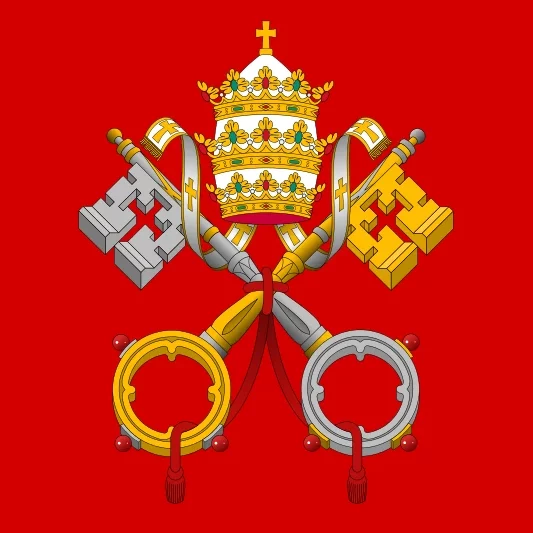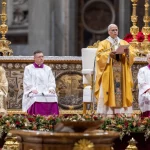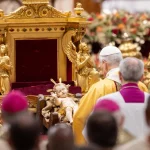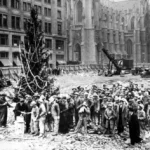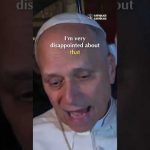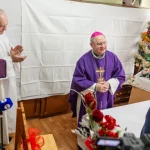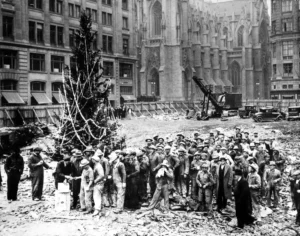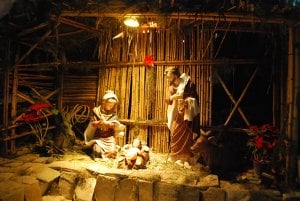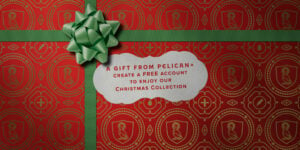We continue this liturgical year’s task with a look into Colossians 1:12-20, our pericope for Holy Mass at the Epistle for this last Sunday of October. As the last October Sunday, it is the Feast of Christ the King in the Church’s 1962 calendar. In the Novus Ordo Christ as King is celebrated on the last Sunday of the liturgical year before Advent begins. The shift of calendar locations reveals different understandings of the feast.
The royal families of Europe were falling one by one. Secularist atheistic materialism was on the rise. In the wake of the gory First World War Pope Pius XI looked out over the world. In 1922, Pius issued an encyclical letter Ubi arcano which directed people to the “Peace of Christ in the Kingdom of Christ”. In 1925 with his encyclical Quas primas he established the Feast of Christ the King, fixing it on the last Sunday of a month that Communists coopted for the exaltation of their “permanent revolution”, October.
“Permanent revolution” is the strategy in Communist praxis that goals should be pursued without compromise with the opposition.
In choosing this last Sunday in October, Pius XI also placed Christ the King immediately before the Feast of All Saints and the month of November, during which, and via its dove-tailing with Advent, we are swept by Mother Church into an intense liturgical reflection on the Four Last Things, Death, Judgement, Heaven and Hell. In other words, she gives us a salutary season for getting our priorities straight.
Pope Pius stressed that Christ has dominion and authority over all created things. Christ is King of Kings and Lord of Lords (Rev 19:16). Hence, Pius said that both individuals and societies as a whole are obliged to submit to Christ as their King.
When Christ does not reign, where Christ has been rejected, people are likely to be reduced to depersonalized widgets, disposable by the powerful in the charnel house of atheism. You know the harrowing image used by Vladimir Ilyich Lenin (+1924) about the necessity of the deaths even of millions for the sake of the socialist objective: “You have to break eggs in order to make an omelet!”
So much for our modern liturgical context.
Colossae was a city in Phrygia of Asia Minor, modern day Turkey. During his imprisonment in Rome Paul wrote to the Christian community of Colossae, one of the seven cities mentioned in the Book of Revelation. The first part of the Letter is mainly doctrinal. The second underscores how Christians should behave. The Sunday Epistle for Christ the King is from the first chapter.
The pericope is a hymn, a song either that Paul composed or was being sung in the early Christian communities. It was not unusual in ancient times, or in modern, that songs could have a didactic purpose. You probably have personal experience of learning things with songs, such as your A-B-Cs. In other entries in this series, we’ve seen that Paul had a curriculum of teaching when he went from place to place. It only makes sense. He was well-trained. He had to leave behind people who were well-trained. While he would have tailored his program for each place depending on the local recipients and issues, surely he didn’t make it up from scratch every time. Here Paul employs a tried-and-true pedagogical tool: a song. In this poetic, hymn-like passage there is Christological summary, teaching about the Person of Jesus Christ.
[Brethren: We give] 12 thanks to the Father, who has qualified us to share in the inheritance of the saints in light. 13 He has delivered us from the dominion of darkness and transferred us to the kingdom of his beloved Son, 14 in whom we have redemption, the forgiveness of sins. 15 He is the image of the invisible God, the first-born of all creation; 16 for in him all things were created, in heaven and on earth, visible and invisible, whether thrones or dominions or principalities or authorities—all things were created through him and for him. 17 He is before all things, and in him all things hold together. 18 He is the head of the body, the church; he is the beginning, the first-born from the dead, that in everything he might be pre-eminent. 19 For in him all the fulness of God was pleased to dwell, 20 and through him to reconcile to himself all things, whether on earth or in heaven, making peace by the blood of his cross.
Just as hymns have strophes or self-contained divisions, so too this reading.
At first, Paul speaks of the “saints in light”. Usually when Paul speaks about “the saints” he means other Christians. This time he means those souls who are in Heaven. That leads us logically into soteriology and eschatology, that is, theology of salvation (Greek soter is “savior”), and the Four Last Things, death, judgement, Heaven and Hell. We have been moved from darkness into the “kingdom”, which logically is “light”. We progress from being in darkness completely and under the dominion of the Enemy, into the Kingdom and light in Baptism (though it must be fulfilled) bringing to us the freedom of the children of God. Finally all is realized in the light and the Kingdom itself where we shall be “saints in light”.
As I was writing I had a thought of getting up in the night in pitch darkness and groping about hesitantly even in a familiar room. Finally, we reach a light source. You know the sense of relief, right? Is this how we are in the state of mortal sin? We wake up and realize we are in darkness and we begin to grope our way to the light with a good confession. Then – BAM! – light and relief. One day all of creation will be taken by Christ to Himself and submitted to the Father and – BAM! – there will be light. Let us be with the “saints in light” when the day comes. Please, God.
Paul sings of the structure of the created cosmos. There are things that are visible and that are, to us, invisible. There are earthly things and heavenly. All things were created by the Father’s beloved Son.
Christ is described. He is the Father’s beloved Son who is “king” in His Kingdom, redeemer, and forgiver.
“He is the image of the invisible God.” There could be in this an echo of Genesis 1, in which God made human beings in His “image”. Of course, Christ is the “new Adam” so such image imagery, if I can say that, is appropriate. All through Paul’s writings there is a theme of a “new creation”. This new Adam, Christ, is not, however, a mere man. He is man, yes, and He is God. As Paul says, “all things were created through him and for him … He is before all things, and in him all things hold together.”
That’s not just a man. That’s the man who is also God.
Also, an early Latin Church Father St. Hilary of Poitier wrote about Christ as image. Before creation the Son was the perfect invisible image of the invisible God. In His incarnation the Son became the perfect visible image of the invisible God. Christ Himself explains in the Gospel of John 14:8-10:
8 Philip said to him, “Lord, show us the Father, and we shall be satisfied.” 9 Jesus said to him, “Have I been with you so long, and yet you do not know me, Philip? He who has seen me has seen the Father; how can you say, ‘Show us the Father’? 10 Do you not believe that I am in the Father and the Father in me? The words that I say to you I do not speak on my own authority; but the Father who dwells in me does his works.
From soteriology and eschatology and theology of creation and pure Christology, we have ecclesiology, theology of the nature of the Church, which is Christocentric, Christ-centered:
He is the head of the body, the church;
Sometimes we speak loosely about the “head of the Church”. Most of the time that’s tolerable, since we are speaking somewhat casually. Very often people say that “the Pope is the head of the Church”. No. Christ is the head of the Church. The Pope, Successor of Peter, is Christ’s Vicar on earth. Vicar is from the Latin vicarius, “a substitute, deputy, proxy, a locum tenens”. The Successor of Peter is the visible, substitute “head” of the earthly Church. He is the visible figure of unity, one of the Church’s marks or attributes along with holiness, catholicity and apostolicity. The Petrine (having to do with Peter) ministry of the figure whom we call the “Pope” (papacy is an instituted that over time developed around the office of the Bishop of Rome, Peter’s Successor) is a constitutive element of the Church that solidifies Christ’s gifts to the Church of indefectibility and infallibility.
Ultimately, however, the Pope is not the “head of the Church”. The head of the Church is Christ.
At the top I mentioned that the Feast we celebrate on this last Sunday of October has a different force than that which in the Novus Ordo comes at the last Sunday of the liturgical year. To get a sense of this we can compare the Collect prayers of the Vetus Ordo and the Novus Ordo for Christ the King. Here are super-literal translations rather than official translations: First, the Vetus:
Almighty eternal God, who in Your beloved Son, the King of the whole universe, desired to reestablish all things: propitiously grant; that all the families of the nations, separated by the wound of sin, may be brought under His most sweet sovereignty.
Nations. Here and now. Christ should be acknowledged as King over all human institutions.
The Novus Ordo version:
Almighty eternal God, who desired to renew all things in Your beloved Son, the King of the universe, graciously grant that the whole of creation, having been freed from servitude, may zealously serve Your majesty and praise You greatly without end.
No question that Christ is the King of the universe. However, the concept of sin is not explicit, but merely implied by “servitude”. The reference to nations, the secular sphere, is gone.
In this Sunday’s reading from Colossians 1, we have an emphasis on Christ’s Kingdom – he is “King” – and of “all things”. Not some things. All.
When the Feast was instituted by Pope Pius, he meant “all things”.
All rulership was and is his, including the secular realm, not just intra-churchy structures or the heavenly climes. Everything and every governmental and ruling structure is, ultimately, under Christ’s rule. When His will and the direction of earthy rule get out of sync, nothing good results. Look around. St. Augustine in his City of God remarked that earthly governments are in fact punishments we endure because of Original Sin. This is not how we were originally made to be. These present, earthly institutions are transient, even those of the Church who, seen with the eyes of Faith, remains the spotless Bride. Our earthly solutions for orderly life are unavoidably infected with our woundedness. The eyes of our hearts and minds, therefore, ought always to be seeking that which is above, even as we grope about here in this vale, gazing at the dark glass to see who we are and who is waiting on the other side.
On the other side of the vale and of the glass is LIGHT. Light from Light is sharing Light with us in every instant of our existence and in special beauty and power in the sacraments and the lucid teaching of Holy Mother Church. Stick to the Light.
